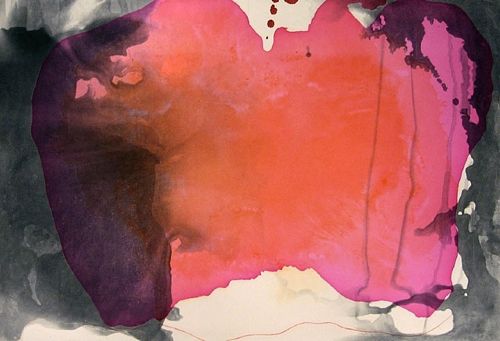In order for students to feel comfortable expressing themselves with a particular medium, they often have to spend plenty of time messing with the stuff they are interested in shaping- be it car parts, plastics, plaster or paint- before they may be ready to create high quality works. A few artists I find myself recommending to students when it comes to specifically “messing” with paint and thinking like an abstract painter include Hans Hoffman, Helen Frankenthaler, Howard Hodgkin and Jessica Stockholder. Each has the potential to pleasantly surprise the viewer, even when you are often stuck with an image a fraction of the actual size, through pure painting and/or the juxtaposition of color. And while Hoffman and Frankenthaler might be known for abstract expressionism, Hodgkin for a more semi-abstraction related to making objects instead of two-dimensional works (painting into and around the frames), and Stockholder for her range of two-dimensional and installation work, the fact remains that the finished work from these artists often reveals a trace, or truckload, of the process the artist used to get there. Asking students to investigate this process is a part of getting them used to really pushing the material and becoming truly familiar with it.
But besides being good examples of artists that really consider their medium in a very obvious way, what else can students learn from artists like Hoffman, Frankenthaler, Hodgkin and Stockholder?
Students have the opportunity to use these artists as a model for working with space and developing complex (vs. complicated) compositions. The principles of balance, juxtaposition and emphasis come into play as each artist forms works that rely heavily on different approaches to balance.
With artists like Hoffman and Frankenthaler, students are able to appreciate color relationships and illusion, as well as study how the immediacy of these works are often anything but immediate.
Hodgkin, while analogous to Hoffman and Frankenthaler, allows students to analyze why the artist would consider himself a “representational” painter that’s not exactly concerned with appearances. What is he representing? Where did these paintings begin? How does Hodgkin use chiaroscuro in ways that are similar to the “masters” centuries ago?
Stockholder encourages students to take Hoffman’s push-pull approach into three dimensions (and maybe we can also draw a relationship with Elizabeth Murray here). Students can be asked to make comparisons to how the previous three painters go about painting vs. how Stockholder goes about painting in space and using similar approaches to working with color.
Jessica Stockholder, Of Standing Float Roots in Thin Air (installation view), 2006. Image: momaps1.org
A few ideas and one announcement before I go…
Give small groups prints or color reproductions by the four artists above- at least two examples by each artist. Ask them to divide the work into three piles but leave the categories up to them in order for students to begin drawing relationships on their own and really looking into the work. Then ask them to arrange the work in some kind of sequence. Finally, ask the group to pick works that illustrate things like excellent composition, effective use of Hoffman’s push-pull, and strong emphasis.
Here’s the announcement: Just a reminder…. Applications are being accepted for Art21 Educators, our yearlong professional development initiative that begins this July here in NYC, through March 17. If you and a colleague are interested in participating please click here to get the ball rolling.
See everyone next week.
